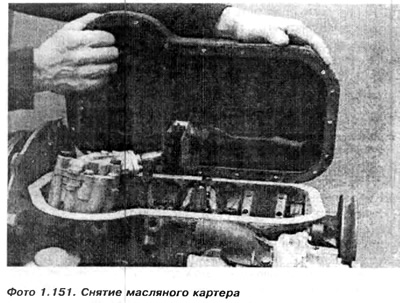A) Tighten the handbrake. Raise the front of the car and support it on stands.
b) Remove the generator wire clamp and disconnect the exhaust pipe (engines 1.1 and 1.3 l).
V) Drain the engine oil into a suitable container. Clean the drain plug and tighten it to a certain torque. The plug gasket needs to be replaced.
G) Unscrew the bolts and separate the oil filter from the cylinder block (photo 1.151). If the gasket is stuck, it can be cut with a knife or lifted with a screwdriver

1. Slowly hammer the screwdriver at the height of the holes after the bolts securing the crankcase, between the sealing surface of the crankcase and the gasket. This is important because during driving the screwdriver and lifting the crankcase will be slightly twisted. We are interested in that possible deformation occurs in places where the crankcase is most closely pressed against the gasket, and also in order to preserve the sealing surface of the engine housing, which is an element much more valuable than the oil sump, which, if necessary, could even be replaced. There is no need to rush when separating a strongly stuck oil sump. After we drive in a screwdriver, it is necessary to raise the crankcase, gradually increasing the force. It turns out that acting even with a relatively small effort for some time, we will get the same effect as with a much larger effort, but in a short period of time. We must remember that the smaller the force, the smaller the deformation of the oil pan. If one screwdriver is not enough, we drive another one at the height of the hole or look for another place where the crankcase does not hold so tightly. Such a place may be a place of possible oil leakage from under the oil sump.
2. After tearing off, the crankcase must be cleaned of gasket residues and immediately leveled. Check the leveling effect by applying the crankcase to a flat surface, for example, an engine housing cleaned of gasket residues. The places that turned out to be concave are leveled outward with a hammer.
Oil sump installation
3. Clean the sealing surfaces of the oil sump and cylinder block.
4. Wash the oil sump.
5. Install a new gasket. Then put the crankcase on the holes, insert the bolts and clamp them crosswise to evenly squeeze the crankcase.
If necessary, the two oil sump bolts near the flywheel can be replaced with socket head bolts. This will facilitate the next disassembly of the crankcase if the engine is in the car.
6. Fill the engine with oil.
7. Fasten the generator wire to the oil sump clamp, and also press the exhaust pipe (engines 1.1 and 1.3 l).
8. Lower the car from stands.

Visitor comments